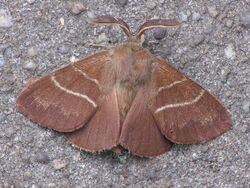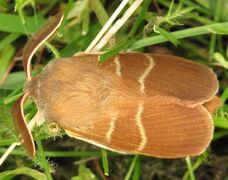Biology:Macrothylacia rubi
| Fox moth | |
|---|---|

| |
| Male | |
| Scientific classification | |
| Domain: | Eukaryota |
| Kingdom: | Animalia |
| Phylum: | Arthropoda |
| Class: | Insecta |
| Order: | Lepidoptera |
| Family: | Lasiocampidae |
| Genus: | Macrothylacia |
| Species: | M. rubi
|
| Binomial name | |
| Macrothylacia rubi | |
| Synonyms | |
| |
Macrothylacia rubi, the fox moth, is a lepidopteran belonging to the family Lasiocampidae. It was first described by Carl Linnaeus in his 1758 10th edition of Systema Naturae.[1]
Distribution and habitat
This species can be found from Western Europe to Central Asia and Siberia.[2][3] These moths live in open woodlands, moors and prairies.[4][5]
Description
The wingspan of the male is 40–65 mm.[5] The wings are reddish brown in males while females are usually paler, more greyish in colour and slightly larger than males. Both sexes show two narrow, straight, light-yellow, transverse bands, running across the forewings. The abdomen is thick, grey brown and hairy.[5] The caterpillars can reach a length of about 80 millimetres (3.1 in). They are initially black with bright yellow or orange segments, later they become darker, always covered with blackish and tawny-coloured hairs and with light grey hair on the sides.[5][6]
Biology
It is a univoltine species. Between September and March the caterpillars hibernate in leaf litter. These moths take flight from May to July. The males usually fly in the afternoon and night, while the females fly only at night.[5] Caterpillars feed on heather (Calluna) bramble (Rubus fruticosus), Gramineae, Betula verrucosa, Salix, Populus tremula, Vicia cracca, Trifolium medium, Trifolium pratense, Vaccinium myrtillus, Fragaria, Potentilla and Geranium sylvaticum.[2][5][7]
Gallery
References
- ↑ "Taxon profile: species: Fox Moth Macrothylacia rubi (Linnaeus, 1758)"]. BioLib.cz. https://www.biolib.cz/en/taxon/id51106/.
- ↑ 2.0 2.1 Savela, Markku. "Macrothylacia rubi (Linnaeus, 1758)". http://www.nic.funet.fi/pub/sci/bio/life/insecta/lepidoptera/ditrysia/bombycoidea/lasiocampidae/lasiocampinae/macrothylacia/#rubi.
- ↑ Fauna Europaea Macrothylacia rubi (Linnaeus 1758) www.faunaeur.org accessed 28 August 2023
- ↑ P. C. Rougeot & P. Viette (1978) (in French). Guide des papillons nocturnes d'Europe et d'Afrique du Nord. Lausanne: Delachaux et Niestlé.
- ↑ 5.0 5.1 5.2 5.3 5.4 5.5 "Fox Moth Macrothylacia rubi". UKMoths. https://ukmoths.org.uk/species/macrothylacia-rubi/.
- ↑ Kimmo Silvonen Larvae of North-European Lepidoptera
- ↑ Paolo Mazzei, Daniel Morel, Raniero Panfili Moths and Butterflies of Europe and North Africa
External links
Wikidata ☰ Q926409 entry
 |








